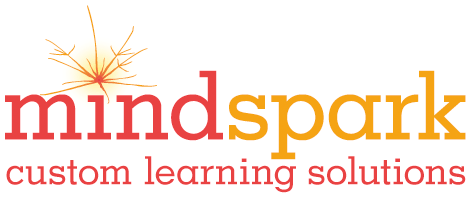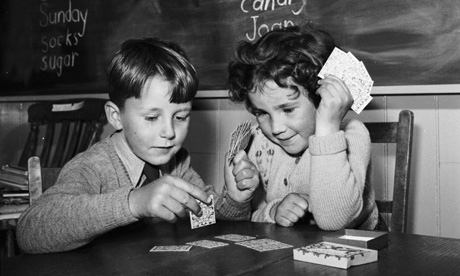As readers of this blog know very well, games are great to incorporate in the classroom for many important, neuropsychological reasons. To summarize, kids learn best when they are having fun.
So, we’ve talked about board games for reviewing phonics.
Today, I want to introduce a handful of card games to get in more of that all-important practice, without kids feeling drilled to death.
The first one I play is Go Fish spelling. The game is just like Go Fish, except instead of looking for books of threes or queens, you and the student are looking for books of rimes or vowels or vowel teams (really, this can be infinitely adapted–you could be looking for anything from a single consonant to the Latin root vis).
To prepare, buy a whole bunch of blank playing cards. Figure out what phonics element you want to practice. Let’s say you want to review rimes with short e. I use sharpies and I color code the sets for a little bit extra support. On four cards, write words that end in est: best, test, rest, pest, for instance. Underline the est. Then do four words that end in end: bend, mend, lend, send. Underline the end. Keep going for six to eight rimes.
Deal out seven cards to each player. I find that little hands have trouble sorting cards, so I give the kids a folder barrier. What do they do behind it? Sort their cards! Yay. You don’t even need to require it–they do it naturally to stay organized. Then the first person asks, “Do you have any e-s-t says /est/?” If yes, you give them all the est cards and they get to go again. If no, then of course they get to go fish. If they draw the pattern they wanted, they get to say “Fish, fish. Got my wish!” (Thanks to Bev Dresden for that fun addition) and go again. If not, it is your turn. Once a person has four (a book) of a pattern, they put it down. Play keeps going until all the cards are gone. If a player runs out cards before play is over, they pull a card from the pile.
Depending on the age of your student, you can start modeling with a think-aloud your strategy, which should include remembering what they have. I also look very pleased when I draw a card I know they have, and this clues them in that they should re-ask something they have said already.
The second card game I play I actually got from Adrian Bruce, a very creative teacher from Australia who has many of these cards games for download. It is called Change, and is rather like UNO. Make a deck of cards that includes ten to fifteen of each of four or five patterns in it, including ten to fifteen change cards. Again, this game is infinitely adaptable from practicing short vowels through affixes and Greek and Latin roots.
You deal seven cards to each player, put the rest face-down in the middle, and turn the top one over next to the pile. Students look in their hand for a match with the face-up card. If they have one, they play it, saying “/ea/ as in each” or “/dis/ as in disturb.” If they don’t have a match, they draw one card. If it matches the target card, they play it. Otherwise, play moves to the next player, who also looks for a match. Of course, the fun is that if the student has a change card, they can play that instead, as long as they call what they are changing to. It is a pretty fast-paced game, although sometimes a single game can seem to last forever, especially if all the change cards are used up early. But it is really fun and gets lots of practice reading words and isolating the target.
One final game I pretty much use only for silent e. I make a bunch of words that are real with and without a silent e. Actually, I have to confess, I use the words from the amazing and catchy Silent E song from The Electric Company (I LOVE You Tube!). So, we have Man and Mane, Pan and Pane, Pin and Pine, etc. You can download the cards I made here.
Note: I do not own the copyright to these images. I am not selling the images or the cards and neither should you. But I think Tom Lehrer and the folks at the Electric Company wouldn’t mind teachers and educational therapists using them to teach this concept.
Then, I play memory/concentration with the cards. I shuffle them, put them all on the table face down, and the student and I take turns turning two cards over. Players say what the partner card is that they are looking for when they flip one over: “Pin, I want Pine. Oh, Tube, that goes with Tub.” The great thing about this game, other than tying in with the video and song (which I do show them first) is that you don’t have to be the best reader to win. In fact, a lot of my kids with dyslexia kick my butt when it comes to spatial memory, so they get to feel quite triumphant. Then, at the end, they read their cards aloud, in their pairs.
If you can think of other phonics targets that would lend themselves to memory/concentration, let me know! Or if you use other card games to make learning and review fun, please share. It’s great to have a whole range of games in the ol’ “Make Learning Fun” tool belt. You’ll have more fun, your students will have more fun, and their brain will be primed to learn. You really can’t ask for more.
copyright Diana Kennedy 2014






Love these card games and can’t wait to try them! I also use Scrabble but change the rules. We play with open racks and we make words together. No real winners or losers but it seems more fun to spell in the context of a game.
That sounds great!
What’s your opinion of hands-on learning games versus simulated online games for effectively teaching the same skills? I think having the game pieces/cards/markers in a child’s hands, whether it’s for a “Go Fish” type game, Bingo, or a board game seems to engage more of their minds and thought processes than what happens with screen simulations (tablets, computers,etc.). More fun, too! I’m interested in hearing others’ experiences.
I think it depends on the kids. I’m not against the iPad if the coolness factor motivates. But real games have different benefits as well–more fine motor skill, for instance, in moving the pieces. Or the spontaneous lesson on shuffling that often occurs. Counting spaces. I can’t tell you how many kids ask if they count the square they are on first. Counting the cards you are dealing out (the difference between seven total cards and seven each…). I also like the simpler games that I can make myself to target exactly what I want. Unless you happen to know how to program iPad apps!
[…] As readers of this blog know very well, games are great to incorporate in the classroom for many important, neuropsychological reasons. To summarize, kids learn best when they are having fun. So, … […]